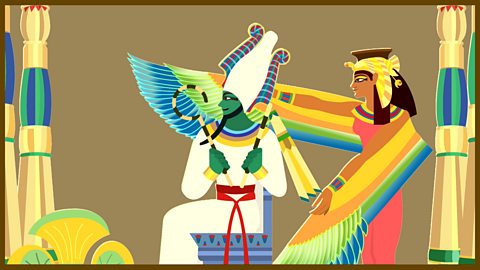The song and other video content explores the critical importance of the River Nile to Ancient Egyptian civilisation.
Waterfall through forest
Starting deep in Africa
Through the lakes and valleys
Heading on a journey north
On its way to Egypt
Full of fishes and birdlife
Living, living river
Living, living River Nile
Villages, mud-houses
Fertile soil and trees of green
Growing flax for linen
Fruit and vegetables too
Growing wheat for baking
Harvest it before the floods
Living, living river
Living, living River Nile
Flowing through the desert
Egypt full of mysteries
Pyramids and sphinxes
Great stone figures, obelisks
Mighty towers and temples
Each a special, sacred place
Living, living river
Living, living River Nile
Crocodile and ibis
Hippopotamus and goose
Fishing boats and trade ships
Sailing with the stuff of life
Flowing to a delta
River journey to the sea
Living, living river
Living, living River Nile
Living, living river
Living, living River Nile
Refer to the Teacher's Notes for more information about the song, including follow-up music activities based on it and suggestions for cross-curricular study.

Why was the River Nile so important to the Ancient Egyptians?
This is a painting that dates back thousands of years to Ancient Egypt.
Artworks like this tell us a lot about the time and place that they come from. This painting shows a farmworker using a shaduf.
It's a very simple machine that can move large amounts of water.
It works like a simple crane. The invention of the shaduf was very important in the story of Ancient Egypt.
It helped people to easily access the water from the River Nile. They built a system of canals to bring the water to the crops a process that's called irrigation.
So it's no accident that one of the greatest and longest-lasting civilisations in history, grew up along the banks of one the world'slongest rivers.
The River Nile is more than six thousand five hundred kilometres in length and it passes through a whopping eleven modern day countries. Of course, back when the pharaohs were in charge the lands around The Nile were totally different.
Without the River Nile, Egypt would be a desert because very little rain falls there.
Luckily, lots of rain does fall upstream, near the sources of the river.
Every year, a very heavy rainfall in the east caused the river levels to rise downstream.
In Ancient Egyptian times, most years, the river then flooded onto the land surrounding it. When the flood water drained away again, the soil that was left behind was rich in nutrients, making it perfect for farming.
The Ancient Egyptians called The Nile 'Ar' which meant black, because that was the colour of the soil and silt left behind after theflooding.
Some years though the river didn't flood properly, causing a drought, when there was not enough water to go round.
Crops failed and famine followed with thousands of Ancient Egyptian people starving to death.
In good times though the river was home to many different species of animals and birds, lots of which made a good meal for anAncient Egyptian.
But not all the animals made a good meal, some were more interested in making a meal out of the hunters.
Crocodiles and hippos were a common sight on The Nile during the Ancient Egyptian period. Hippos are not meat eaters but they can still be very dangerous to humans.
In fact, some people think it was a hippo attack that caused the death of the Pharaoh Tutankhamun.
The Nile was Ancient Egypt's superhighway and was always busy with boats carrying people and goods back and forth to all thesettlements along the banks of the river.
The reeds that lined the sides of the river were also put to good use. It was from these that the Ancient Egyptians created the first form of paper, papyrus.
Reeds were also woven together to make things like baskets and even boats.
With so much of life depending on the river it's no wonder that the Ancient Egyptians gave The Nile its very own god to look after it.
He was called Hapi and the people gave thanks to him for the floodwaters.
So you see? The River Nile really was crucial to the long success of Ancient Egypt.
The River Nile
The video explores the vital role the River Nile played in the success of Ancient Egypt.
It begins by highlighting the role of the shaduf - a tool used to move water from one place to another, thus allowing use of water from the Nile in the irrigation of crops.
The video also covers how important the river was to daily life, highlighting the various ways the river was used in normal years when the water was plentiful - but also the disaster that befell Ancient Egyptians in times of drought.
Pupils will see the wildlife and resources that came from the River Nile and how these were used in the advancement of Ancient Egyptian civilisation, including food and also how reeds were used for making a wide variety of essential items, including papyrus (the first form of paper) and simple boats.
The Nile was so significant to the Ancient Egyptians that they gave the river its own god, called Hapi.

Resources
Song: 'Living, living River Nile' - Instrumental
Waterfall through forest
Starting deep in Africa
Through the lakes and valleys
Heading on a journey north
On its way to Egypt
Full of fishes and birdlife
Living, living river
Living, living River Nile
Villages, mud-houses
Fertile soil and trees of green
Growing flax for linen
Fruit and vegetables too
Growing wheat for baking
Harvest it before the floods
Living, living river
Living, living River Nile
Flowing through the desert
Egypt full of mysteries
Pyramids and sphinxes
Great stone figures, obelisks
Mighty towers and temples
Each a special, sacred place
Living, living river
Living, living River Nile
Crocodile and ibis
Hippopotamus and goose
Fishing boats and trade ships
Sailing with the stuff of life
Flowing to a delta
River journey to the sea
Living, living river
Living, living River Nile
Living, living river
Living, living River Nile
Teacher's Notes. document
Information and guidance on the songs and other content in KS2 Music: Ancient Egypt
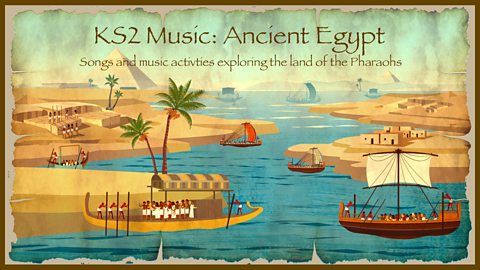
Living, living River Nile - Lyrics. document
Print / download the lyric sheet (pdf)
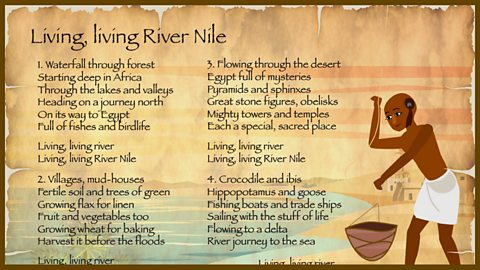
Living, living River Nile - Music. document
Print / download the music sheet (pdf)
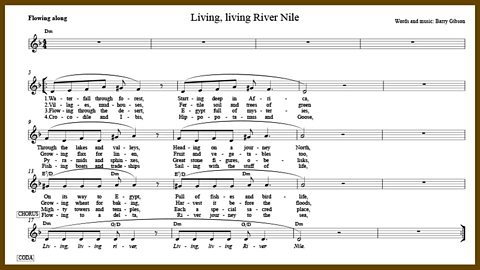
Download audio
Download the backing track of the song (mp3)

Nile boat. image
Click to display the image full-size


More from KS2 Music: Ancient Egypt
Build that pyramid
A lively, energetic work song covering the building and function of the pyramids and their changing styles.
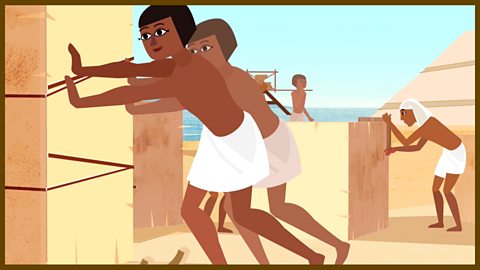
Out of the gloom, Tutankhamun
Exploring the life and death of Tutankhamun and the discovery of his tomb in 1922 by Howard Carter.
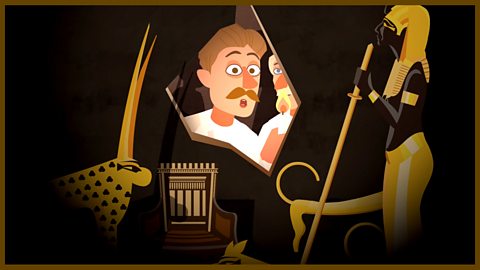
So many gods and goddesses
Covers the rituals and beliefs of the Ancient Egyptians, including their many gods and goddesses.
